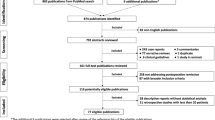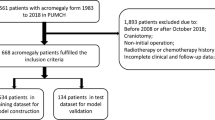Abstract
Background
Some laboratory and clinical features are associated with a probability of recurrence after transnasal adenomectomy for Cushing disease (CD). However, there is no consensus on a set of predictors. Rules for prediction of recurrence were not proposed earlier.
Aim
To develop prediction model of recurrence/remission after successful neurosurgical treatment for CD.
Methods
Retrospective single-site comparative study included 349 patients (52 men and 297 women) with a verified diagnosis of CD who underwent effective endoscopic transsphenoidal adenomectomy between 2007 and 2014. Clinical and laboratory parameters were evaluated. Laboratory tests were performed using immunochemiluminescent method. Time-to-event analysis and ROC-analysis were applied. Multivariate models were developed using logistic regression and artificial neural network (ANN).
Results
Postoperative cortisol and ACTH levels and their combinations cannot be used for prediction of recurrence. ANN for prediction of recurrence within 3 years after successful surgery was developed. Input variables are age, duration of the disease, MRI data on adenoma, morning postoperative levels of ACTH and cortisol, output variable is binary (recurrence/remission). Predictive value for remission is 93%, 95% CI [89%; 96%], and predictive value for recurrence is 85%, 95% CI [71%; 94%]. Web-calculator based on the model is developed and free for use.
Conclusion
Effective method for prediction of recurrence and long-term remission within 3 years after successful endoscopic transsphenoidal adenomectomy is proposed.



Similar content being viewed by others
Notes
Data on 4 of 223 cases became available after the multivariate analysis was performed.
References
Biller B, Grossman A, Stewart P et al (2008) Treatment of adrenocorticotropin-dependent Cushing’s syndrome: a consensus statement. Clin Endocrinol Metab 93:2454–2462. https://doi.org/10.1210/jc.2007-2734
Nieman L, Biller B, Findling J et al (2015) Treatment of Cushing’s syndrome: an Endocrine Society clinical practice guideline. J Clin Endocrinol Metab 100(8):2807–2831. https://doi.org/10.1210/jc.2015-1818
Bochicchio D, Losa M, Buchfelder M (1995) Factors influencing the immediate and late outcome of Cushing’s disease treated by transsphenoidal surgery: a retrospective study by the European Cushing’s Disease Survey Group. J Clin Endocrinol Metab 80:3114–3120. https://doi.org/10.1210/jcem.80.11.7593411
Hameed N, Yedinak CG, Brzana J et al (2013) Remission rate after transsphenoidal surgery in patients with pathologically confirmed Cushing’s disease, the role of cortisol, ACTH assessment and immediate reoperation: a large single center experience. Pituitary 16:452–458. https://doi.org/10.1007/s11102-012-0455-z
McCance D, Gordon D, Fannin T et al (1993) Assessment of endocrine function after transsphenoidal surgery for Cushing’s disease. Clin Endocrinol (Oxf) 38:79–86. https://doi.org/10.1111/j.1365-2265.1993.tb00976.x
van Aken M, de Herder W, van der Lely A et al (1997) Postoperative metyrapone test in the early assessment of outcome of pituitary surgery for Cushing’s disease. Clin Endocrinol (Oxf) 47:145–149. https://doi.org/10.1046/j.1365-2265.1997.2541051.x
Shimon I, Ram Z, Cohen Z et al (2002) Transsphenoidal surgery for Cushing’s disease: endocrinological follow-up monitoring of 82 patients. Neurosurgery 51(1):57–61. https://doi.org/10.1210/er.2013-1048
Alexandraki K, Kaltsas G, Isidori A et al (2013) Long-term remission and recurrence rates in Cushing’s disease: predictive factors in a single-centre study. Eur J Endocrinol 168:639–648. https://doi.org/10.1530/EJE-12-0921
Aranda G, Enseñat J, Mora M et al (2015) Long-term remission and recurrence rate in a cohort of Cushing’s disease: the need for long-term follow-up. Pituitary 18:142–149. https://doi.org/10.1007/s11102-014-0567-8
Barbetta L, Dall’Asta C, Tomei G et al (2001) Assessment of cure and recurrence after pituitary surgery for Cushing’s disease. Acta Neurochir (Wien) 143:477–482. https://doi.org/10.1007/S007010170077
Petersenn S, Beckers A, Ferone D et al (2015) Therapy of endocrine disease: outcomes in patients with Cushing’s disease undergoing transsphenoidal surgery: systematic review assessing criteria used to define remission and recurrence. Eur J Endocrinol 172(6):227–239. https://doi.org/10.1530/EJE-14-0883
Lonser R, Nieman L, Oldfield E (2017) Cushing’s disease: pathobiology, diagnosis, and management. J Neurosurg 126(2):404–417. https://doi.org/10.3171/2016.1.JNS152119
Kim J, Shin C, Paek S et al (2012) Recurrence of Cushing’s disease after primary transsphenoidal surgery in a university hospital in Korea. Endocr J 59(10):881–888. https://doi.org/10.1507/endocrj.EJ12-0109
Dedov II, Melnichenko GA (eds) (2016) Russian clinical guidelines. Endocrinology, Moscow (in Russian)
Pettersen J, Halvorsen H, Evang J et al (2015) Low immediate postoperative serum-cortisol Nadir predicts the short-term, but not long-term, remission after pituitary surgery for Cushing’s disease. BMC Endocr Disord 15:62. https://doi.org/10.1186/s12902-015-0055-9
Marova E., Arapova S, Belaya Z et al (2012) Cushing’s disease: the clinical features, diagnostics, treatment. In: Dedov, II, Melnichenko GA (eds) Practical guide for doctors. Moscow, pp 2–32 (in Russian)
Melnichenko G, Dedov I, Belaya Z et al (2015) Cushing’s disease: the clinical features, diagnostics, differential diagnostics, and methods of treatment. Probl Endocrinol 61(2):55–77. https://doi.org/10.14341/probl201561255-77 (in Russian)
Roelfsema F, Biermasz N, Pereira A et al (2012) Clinical factors involved in the recurrence of pituitary adenomas after surgical remission: a structured review and meta-analysis. Pituitary 15(1):71–83. https://doi.org/10.1007/s11102-011-0347-7
Dickerman R, Oldfield E (2002) Basis of persistent and recurrent Cushing disease: an analysis of findings at repeated pituitary surgery. Neurosurgery 97(6):1343–1349. https://doi.org/10.3171/jns.2002.97.6.1343
Oldfield E (2011) Surgical management of Cushing’s disease: a personal perspective. Clin Neurosurg 58:13–26. https://doi.org/10.1227/neu.0b013e3182269d3f
Wislocky G (1938) The vascular supply of the hypophysis cerebri of the Rhesus monkey and man. Proc Assoc Res Ment Dis 17:48–68
Burke W, Penn D, Repetti C et al (2019) Outcomes after repeat transsphenoidal surgery for recurrent Cushing disease: updated. Neurosurgery. https://doi.org/10.1093/neuros/nyz193
Jagannathan J, Smith R, DeVroom H (2009) Outcome of using the histological pseudocapsule as a surgical capsule in Cushing disease. J Neurosurg 111(3):531–539. https://doi.org/10.3171/2008.8.JNS08339
Dallapiazza R, Oldfield E, Jane J (2015) Surgical management of Cushing’s disease. Pituitary 18(2):211–216. https://doi.org/10.1007/s11102-015-0646-5
Reincke M, Sbiera S, Hayakawa A et al (2015) Mutations in the deubiquitinase gene USP8 cause Cushing’s disease. Nat Genet 47:31–38. https://doi.org/10.1038/ng.3166
Ma ZY, Song ZJ, Chen JH et al (2015) Recurrent gain-of-function USP8 mutations in Cushing’s disease. Cell Res 25(3):306–317
Perez-Rivas L, Theodoropoulou M, Ferraù F et al (2015) The gene of the ubiquitin-specific protease 8 is frequently mutated in adenomas causing Cushing’s disease. J Clin Endocrinol Metab 100:E997–E1004. https://doi.org/10.1210/jc.2015-1453
Albani A, Pérez-Rivas L, Dimopoulou C et al (2018) The USP8 mutational status may predict long-term remission in patients with Cushing’s disease. Clin Endocrinol. https://doi.org/10.1111/cen.13802
Marova E, Kolesnikova G, Arapova S et al (2016) Factors predicting the outcomes of removal of corticotropinom in Cushing’s disease. Endocr Surg 10(4):20–30. https://doi.org/10.14341/serg2016420-30 (in Russian)
Galiana P, Montañana C, Riesgo Suárez P et al (2013) Predictors of long-term remission after transsphenoidal surgery in Cushing’s disease. Endocrinol Nutr 60(8):475–482. https://doi.org/10.1016/j.endonu.2012.09.009
Bansal P, Lila A, Goroshi M et al (2017) Duration of post-operative hypocortisolism predicts sustained remission after pituitary surgery for Cushing’s disease. Endocr Connect 6(8):625–636. https://doi.org/10.1530/EC-17-0175
Johnston P, Kennedy L, Hamrahian A et al (2017) Surgical outcomes in patients with Cushing’s disease: the Cleveland Clinic experience. Pituitary. https://doi.org/10.1007/s11102-017-0802-127
Lambert J, Goldberg L, Fayngold S et al (2013) Predictors of mortality and long-term outcomes in treated Cushing’s disease: a study of 346 patients. J Clin Endocrinol Metab 98(3):1022–1030. https://doi.org/10.1210/jc.2012-2893
Acknowledgements
The authors thank M.S. Antyukh for programming the web calculator.
Author information
Authors and Affiliations
Corresponding author
Ethics declarations
Conflict of interest
All authors on this manuscript have declared that they have no conflict of interest.
Ethical approval
The study protocol was approved by the Local Ethical Committee of the Endocrinology Research Centre.
Additional information
Publisher's Note
Springer Nature remains neutral with regard to jurisdictional claims in published maps and institutional affiliations.
Rights and permissions
About this article
Cite this article
Nadezhdina, E.Y., Rebrova, O.Y., Grigoriev, A.Y. et al. Prediction of recurrence and remission within 3 years in patients with Cushing disease after successful transnasal adenomectomy. Pituitary 22, 574–580 (2019). https://doi.org/10.1007/s11102-019-00985-5
Published:
Issue Date:
DOI: https://doi.org/10.1007/s11102-019-00985-5




